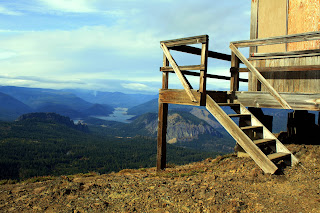Book Review: "East of the Divide" by Chester Marler
Photo by Matt Dahlgreen
“East of the Divide (Travels through the eastern slope of the
North Cascades, 1870-1999”, by Chester Marler: North Fork Books, 2004- Leavenworth, WA 98826.
Photo by Tom Hulst
The East Slope of the Washington Cascades, running north from
the Columbia River to Canada is a large, rugged mountainous zone that, along
with it’s foothills and river basins, has generated a lot of classic mountain
literature. Standing in my bookshelf is
a number of books of exceptional quality that includes the historical meandering
and mountain lore of Fred Becky, the classic 1880 -1931 mountain reminiscence
by Claude Rusk “Tales of a Western Mountaineer” and the early memoirs of
Supreme Court Justice William O. Douglas, (“Of Men and Mountains”) who followed
his boots and thoughts from 1917 up to 1951.
All of these books are worth rereading time and again and they are the
pillars on which we measure our own mountain walks.
Winter Waterfall, Cowiche Canyon, photo by Jo Miles
In 2004 North Fork Books in Leavenworth released Chet Marler’s
“East of the Divide”, a unique book in it’s own right that carries the
conversation started by earlier mountain pioneers and writers to the next level. Marler’s book is a lot like hiking with a
friend, and the familiar sounding narriative articulates thoughts about place,
setting, relevant history, and human use, all in an even and thoughtful voice.
Shellrock Peak, photo by Jo Miles
Disguised as a wandering trail guide and historical review, the
book calls on just about every whistle stop that one would expect from a long
hike with a friendly Wilderness Ranger. Every page has hidden gems, all too numerous to mention; insight
into place, approaches to reading the setting, and thoughts about “the
edge”. Examples include : “Serrated
skyline,,, where I naturally became immersed in the details of the landscape… in
the mountain not everything of value is spectacular, imposing, or
overwhelming….even a struggling white bark pine growing in a rocky outcrop, or
a grouse making its mating call can
become starting points in perceiving the complexity and beauty of the natural
world…..something that survives that long (a giant Larch) gives us a different sense of time, changing
our perspective of place and process……scramble trails”, and etc.
Lookout Outhouse, photo by Jo Miles
Likewise, the mention of Old Fire Lookout views, abandoned single
strand phone line insulators, hollowed-out
mountain goat beds, a photo of the old cabin at Spanish Camp, Sheep herder
trails and travelways, Trail blazes, and the host of similar details bring the
hiking stories alive and gives us tie points to cross check our own pedestrian rambles.
Who, for example, will know in 100 years that some pack horses are better than
other pack horses or understand so well what that really means (p. 190) without
Chet’s kind words.
Ross Lake from Desolation, photo by Kristin Hiler
Much like Walden, this is a book about seeing, expressed in the
context of long walks. What it imparts
is the casual, understated poetry of the measured narrative responding to
alpine setting. Modern mountain poets
would do well to dip from these pedestrian rhythms and patient observations/mh.
Man examines tree: photo by Matt Dahlgreen
A few more words: Chetster Marler also has a book out by Wolverine Press, titled, "Snow and Spire". The photos on the attached link to a "Snow and Spire" review look great! The link to information about that book is:
http://www.justgetout.net/Wenatchee/23241
Just click on the link above and you can see photos.





















